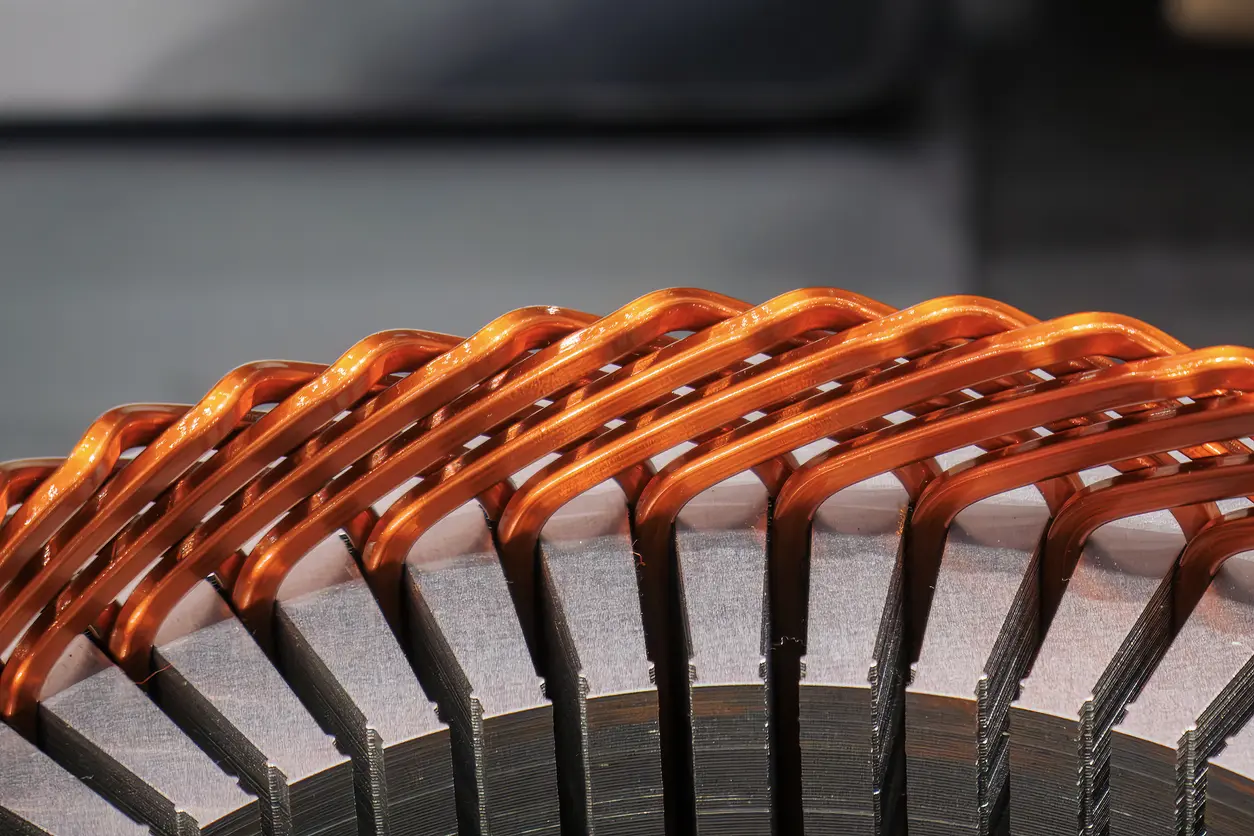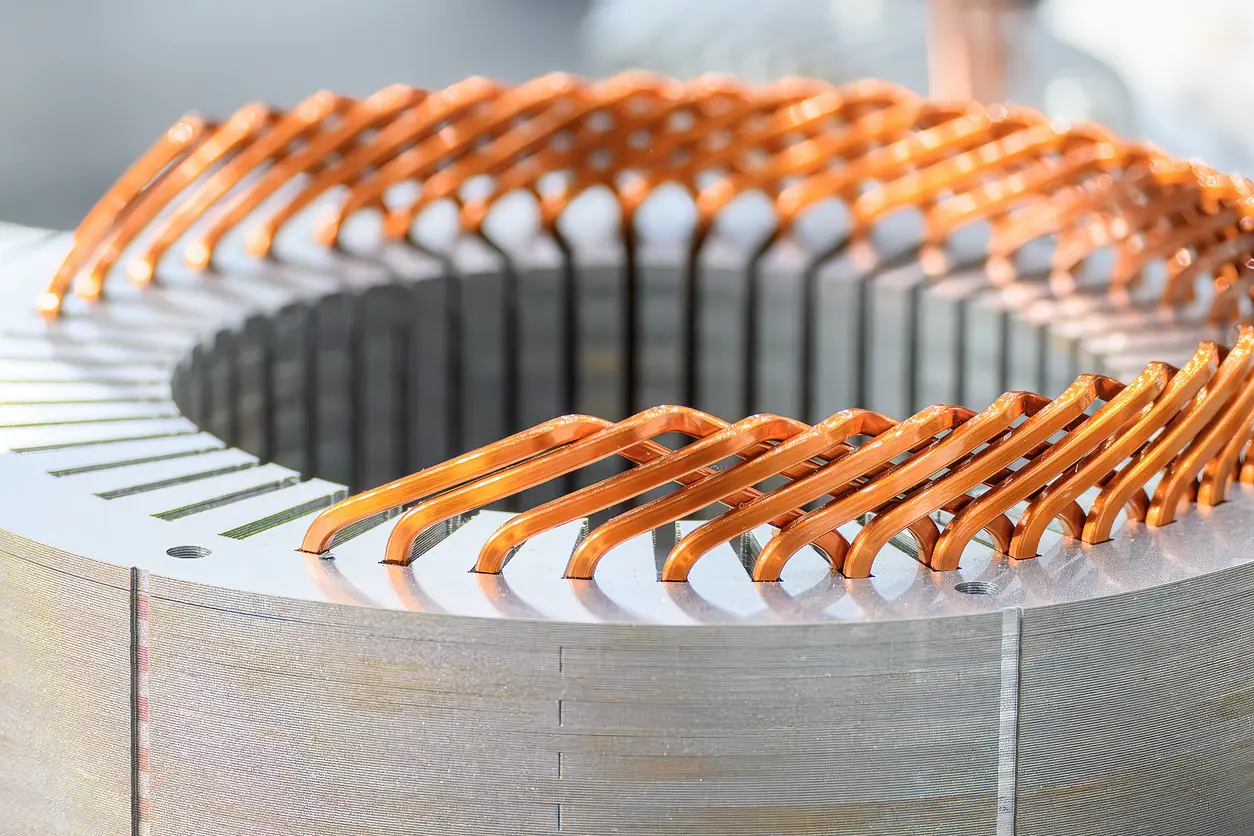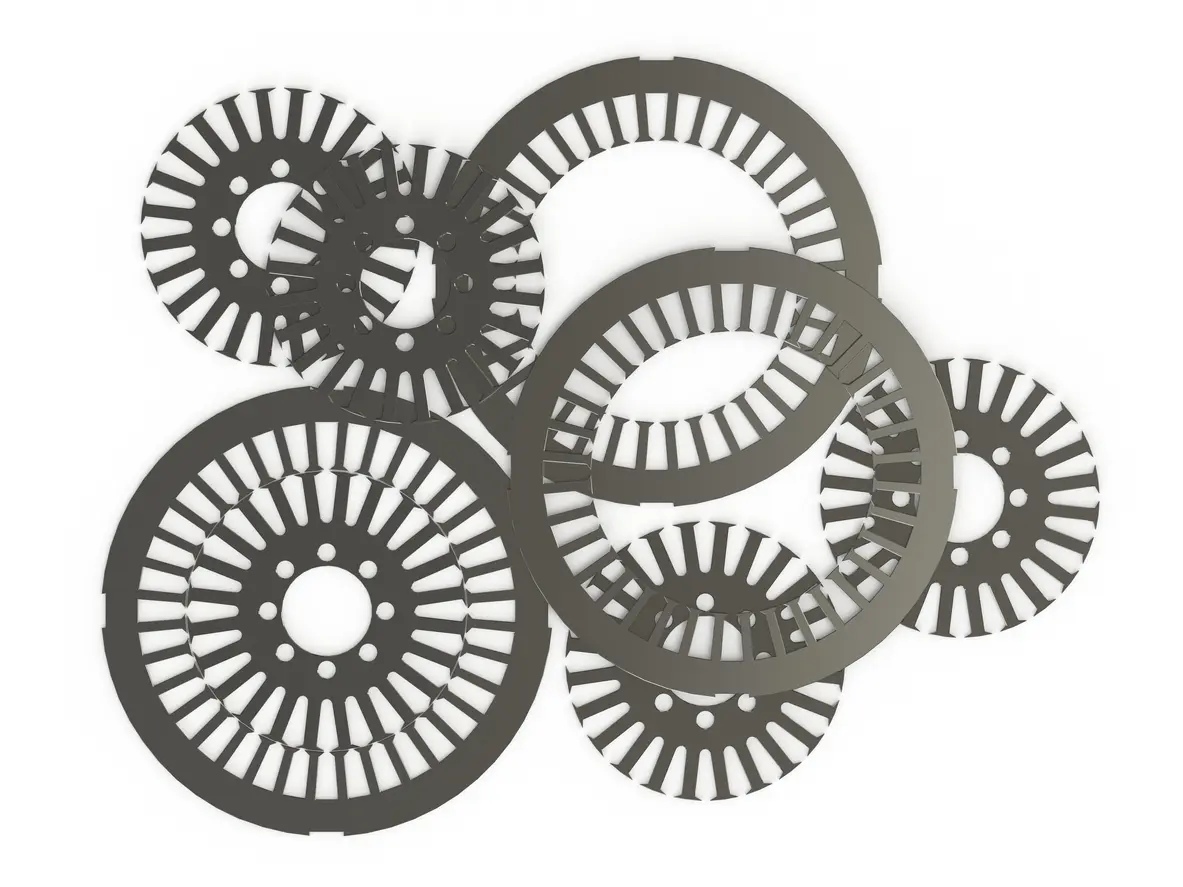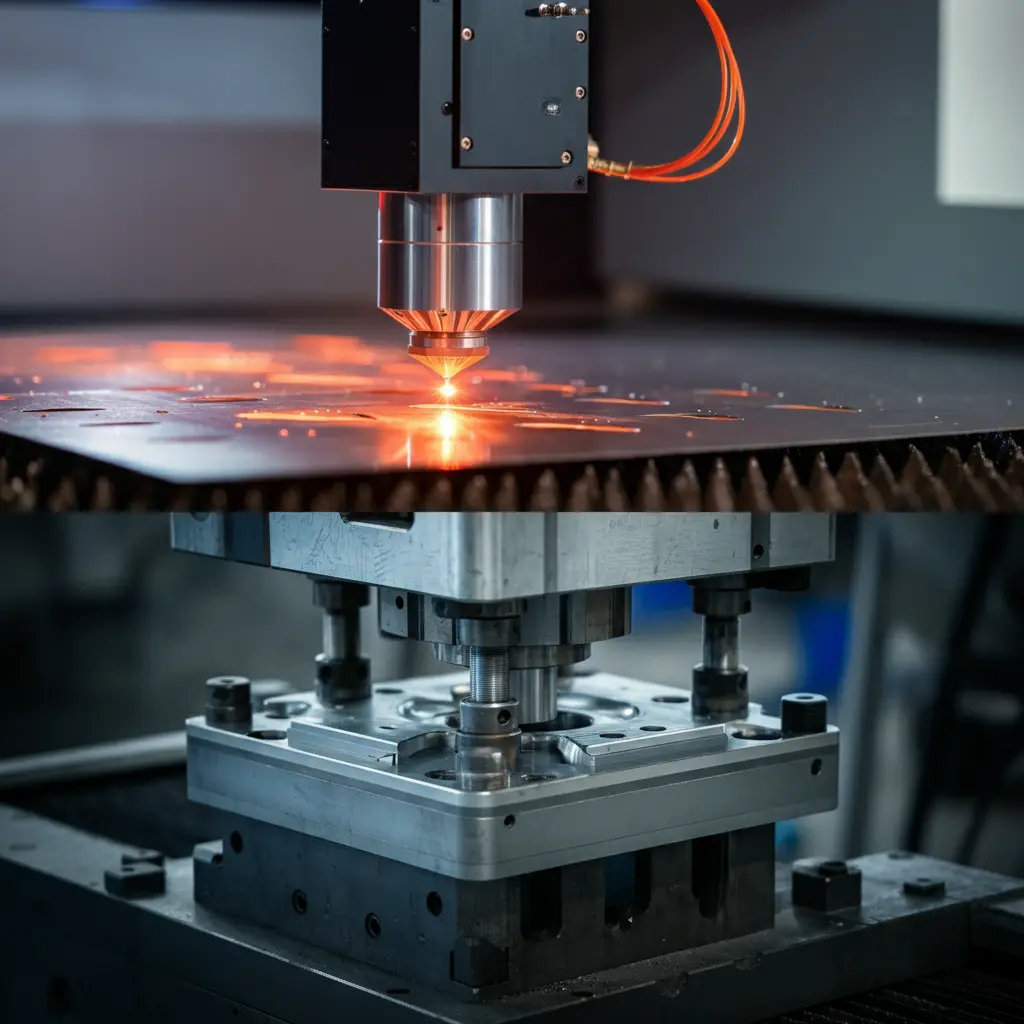1. Introduction: What Is a Self-Bonding Lamination Stack?
1.1 Definition and Key Features
A self bonding lamination stack refers to a series of thin electrical steel sheets coated with a specialized bonding material that adheres each layer to its adjacent one without requiring mechanical fasteners. This bonding process often involves specialized adhesives, epoxy coatings, or other insulating treatments. By eliminating the need for rivets or welding, the lamination stack can be manufactured with a more uniform surface and tighter tolerances.
One notable feature of a self bonding lamination stack is its ability to minimize the gaps between layers, thereby reducing undesirable effects such as eddy currents and unwanted vibrations. Additionally, this approach can enhance thermal management, as there are fewer inconsistencies in the lamination surfaces. As a result, heat dissipation becomes more efficient, helping to prolong the operational life of the motor or generator in which these stacks are employed.
1.2 Importance in Modern Electric Motor Cores
The growing emphasis on energy efficiency and sustainability in today’s industries has placed the self bonding lamination stack at the forefront of electric motor core design. By reducing the size of air gaps and improving overall structural integrity, these stacks contribute significantly to lower electrical losses, higher power density, and quieter operation. This is increasingly relevant in sectors such as electric vehicles, robotics, and various industrial applications where energy savings and performance are primary concerns.
Moreover, a self bonding lamination stack can offer enhanced reliability over time, as the risk of lamination separation is diminished. The uniform, bonded layers can also lower the likelihood of vibration-related damage or noise pollution—an important consideration in environments where strict noise regulations apply. Ultimately, this solution supports a balanced approach: achieving high performance while maintaining a conservative stance on manufacturing costs, materials, and environmental impact.
2. Benefit #1: Enhanced Core Efficiency
2.1 Reduced Eddy Current Losses
One of the most significant advantages of a self bonding lamination stack is the potential to reduce eddy current losses in electric motor cores. Eddy currents arise when alternating magnetic fields pass through steel laminations, generating unnecessary heat and energy dissipation. By precisely bonding each layer without mechanical fasteners, manufacturers can achieve more uniform layer-to-layer contact. This uniformity often leads to fewer gaps where unwanted currents could circulate.
In many cases, a carefully bonded stack also promotes better insulation between each lamination, further mitigating the pathways for eddy currents. While there is no single standard that guarantees a specific percentage of loss reduction, some industry professionals have observed notable improvements in efficiency compared to traditional lamination methods. Still, it is reasonable to note that real-world results can vary depending on factors such as motor design, operating frequency, and the quality of the bonding material.
2.2 Lower Operating Temperature
Another way a self bonding lamination stack can enhance core efficiency is by helping control temperature levels within the motor. When eddy current losses are reduced, less heat is produced, naturally leading to lower operating temperatures. This can be especially valuable in applications where prolonged or high-speed operation is required, as excessive heat buildup may shorten the lifespan of internal components.
Additionally, lower operating temperatures can contribute to reduced energy consumption for cooling measures, potentially leading to overall cost savings. The stronger layer cohesion in a self bonding lamination stack also helps distribute heat more uniformly, potentially stabilizing motor performance over extended periods. While these benefits have been observed in various industries, actual improvements may differ from case to case based on design parameters and usage conditions. Nevertheless, many manufacturers consider lower operating temperatures a compelling reason to explore self bonding options for their lamination stacks.
3. Benefit #2: Improved Structural Integrity
3.1 Bonding Mechanisms
A self bonding lamination stack relies on specialized materials—such as epoxy coatings, resin-based adhesives, or insulating layers—to securely hold individual steel sheets together. In contrast to conventional methods involving rivets or spot welding, this approach typically distributes bonding more uniformly across the entire surface of each lamination. As a result, the layers tend to align more precisely, which may enhance overall structural coherence.
The specific bonding mechanism can vary by manufacturer and project requirements. Some solutions use heat-activated adhesives, while others apply pressure and curing agents. Although these techniques are designed to ensure a robust bond, it is worth noting that performance can still depend on factors like the quality of the base steel, the adhesive properties, and the process parameters selected during production. In general, when properly implemented, a self bonding lamination stack can offer an improved balance of stiffness and stability compared to traditional methods.
3.2 Minimizing Delamination Risks
Delamination is a common concern in motor cores, as gaps between laminations may gradually develop when mechanical joints loosen, especially under vibration or thermal cycling. By employing a self bonding lamination stack, the likelihood of these gaps forming can be diminished. The adhesive layer spreads the stress more evenly, rather than focusing it on a few rivet points or welded joints. This can translate into lower risks of lamination shifts or peeling over time.
Additionally, reduced internal stress may help preserve the insulation layers between laminations, which in turn contributes to better electrical performance. While it is prudent to recognize that real-world conditions—such as extreme temperatures or high rotational speeds—can still present challenges, many industry professionals have identified self bonding methods as a potential way to bolster the long-term durability of motor cores. Nevertheless, manufacturers often recommend thorough testing to confirm that the chosen bonding technique meets the specific demands of each application.
4. Benefit #3: Superior Noise and Vibration Reduction
4.1 How Bonding Affects Acoustic Performance
A self bonding lamination stack can be advantageous for reducing the noise and vibration commonly associated with electric motors. When individual laminations are secured with uniform bonding layers—rather than rivets or spot welds—they tend to have fewer points of mechanical looseness. This reduction in physical gaps often results in less rattling or humming during operation, as each steel sheet remains more consistently in place even under high-speed rotation.
Additionally, the adhesive or coating material used in a self bonding lamination stack may possess damping properties that can help absorb some of the vibrational energy. While the degree of noise reduction will differ based on factors such as motor speed, load, and the specific bonding method chosen, many manufacturers see this approach as a potentially worthwhile option for applications where acoustic performance is a high priority. Nonetheless, it is important to evaluate each design on a case-by-case basis to ensure that the bonding solution meets the intended performance criteria.
4.2 Impact on End-User Experience
Noise and vibration levels can have a notable influence on user satisfaction, particularly in consumer-facing products like home appliances or electric vehicles. A self bonding lamination stack tends to produce smoother motor operation, which can contribute to a more pleasant experience overall. Quieter operations are also beneficial in industrial environments, where employee comfort and adherence to noise regulations play a significant role in workplace safety and productivity.
Beyond user comfort, reduced vibration can help improve the lifespan of the motor itself. Excess motion or oscillation may place additional stress on bearings and other components, potentially leading to premature wear or failure. By employing a self bonding lamination stack that is designed to minimize these effects, engineers can help ensure that electric motors operate more reliably over time. It is advisable, however, to conduct thorough testing under the specific operating conditions for which the motor is intended, as real-world outcomes can vary.
5. Benefit #4: Reduced Manufacturing Complexity
5.1 Streamlined Assembly Processes
One noteworthy advantage of a self bonding lamination stack is the ability to streamline various aspects of motor core assembly. Traditional lamination processes often require riveting, welding, or other mechanical fasteners to secure individual steel sheets. In contrast, self bonding materials—such as epoxy coatings or resin-based adhesives—adhere each lamination to the next without the need for extra parts or specialized fastening equipment. As a result, manufacturers may find it less complex to manage inventory and coordinate production steps, potentially avoiding bottlenecks that can arise when separate fastening procedures need precise synchronization.
Additionally, a self bonding lamination stack can help minimize the minor misalignments that sometimes occur with mechanical fastening methods. By curbing the possibility of lamination shift during assembly, this approach may yield more consistent stack geometries and, in some cases, more stable motor performance. Nevertheless, it remains advisable for organizations to carefully evaluate factors like adhesive type, curing time, and quality control measures before fully transitioning to a self bonding process.

5.2 Time and Cost Savings
The streamlined nature of a self bonding lamination stack also has implications for time and cost efficiency. When fewer production steps are required, there is often a corresponding reduction in labor for tasks such as drilling holes, positioning fasteners, and conducting post-assembly inspections. Over extended production runs, these incremental savings can become considerable, making self bonding solutions attractive for high-volume applications like electric vehicle motors or commercial machinery.
Moreover, lower process complexity can limit opportunities for assembly errors or rework, potentially cutting down on scrap rates and material costs. While the exact benefits will vary depending on the scale and specifics of each manufacturing operation, many companies consider self bonding technology to strike a balance between performance, cost-effectiveness, and long-term reliability. It is generally recommended, however, that pilot tests and thorough evaluations be conducted to confirm that a given self bonding approach aligns with the unique requirements of each motor design.
6. Benefit #5: Enhanced Design Flexibility
6.1 Custom Shapes and Dimensions
A self bonding lamination stack can offer a higher degree of design freedom compared to traditional stacking methods that rely on mechanical fasteners. Because individual laminations are bonded together through specialized coatings or adhesives, engineers may find it easier to accommodate intricate contours or unconventional geometries. In certain cases, this flexibility opens up possibilities for optimizing motor core shapes to improve performance characteristics such as torque density, airflow, or heat dissipation.
Moreover, since there are fewer mechanical constraints to consider (for example, rivet holes or weld seams), design teams can focus on fine-tuning lamination thicknesses or layering patterns. This might prove especially beneficial for applications that require compact yet powerful motor cores, such as electric vehicle motors or robotic actuators. While the practical limits will still depend on factors like material properties and bonding techniques, a self bonding lamination stack frequently presents an opportunity for more imaginative and tailored approaches to motor design.
6.2 Rapid Prototyping Opportunities
Another advantage of opting for a self bonding lamination stack is the potential for quicker prototyping cycles. Traditional methods often involve setting up specialized jigs, drilling patterns for fasteners, and conducting post-assembly verifications to ensure proper alignment. In contrast, self bonding processes may reduce the number of steps required to test new design iterations, making it simpler to explore multiple configurations without incurring excessive setup times or retooling costs.
This streamlined approach can be especially useful when exploring different core geometries or lamination materials early in the development process. By accelerating prototyping and reducing potential assembly errors, development teams can gather data faster, refine designs with greater agility, and ultimately reach production decisions more efficiently. Although each project’s specifics—including the type of adhesive or coating—should be carefully evaluated, many manufacturers have noted that self bonding technology can strike a practical balance between innovative design and real-world feasibility.

7. Benefit #6: Environmentally Friendly Approach
7.1 Less Waste
A self bonding lamination stack can contribute to more eco-friendly manufacturing by reducing the need for mechanical fasteners like rivets or weld points. Fewer separate components mean lower consumption of metals and other materials, which helps curtail overall production waste. Likewise, the uniform bonding of laminations often results in fewer rejected or defective parts, as there is less chance for misalignment and delamination during assembly. This can be particularly meaningful in large-scale production environments, where even minor improvements in scrap reduction can yield considerable environmental benefits.
In addition, eliminating the drilling or punching required for rivets can reduce metal shavings and other byproducts. The adhesives or coatings used in a self bonding lamination stack are generally engineered to have minimal impact on surrounding components, and some formulations even comply with stricter environmental regulations. Overall, while the extent of waste reduction will vary with each project, industry reports suggest that the self bonding approach can support a more resource-efficient manufacturing process.
7.2 Energy-Efficient Production
Beyond material savings, a self bonding lamination stack may also improve energy efficiency during the assembly stage. Riveting and welding processes often require specialized machinery or heat input, contributing to higher energy consumption. In contrast, bonding techniques—especially those that rely on ambient curing or moderate heat—can potentially lower the overall energy footprint, reducing operational costs and greenhouse gas emissions.
In certain cases, the enhanced stack uniformity achieved by self bonding can translate into motors that run cooler and more efficiently. When motors operate at lower temperatures, the system may require less external cooling, which can further decrease energy use over the product’s life cycle. While results will naturally depend on variables like adhesive selection, production volume, and design intricacy, self bonding technology tends to align well with the growing demand for more sustainable, energy-conscious manufacturing practices.
8. Conclusion: Maximizing the Advantages of Self-Bonding Lamination Stacks
8.1 Recap of the 7 Benefits
A self bonding lamination stack can enhance core efficiency, improve structural integrity, reduce noise and vibration, streamline manufacturing, increase design flexibility, and promote more eco-friendly practices. By eliminating or minimizing mechanical fasteners, manufacturers may achieve tighter tolerances and reduce production complexities. Although real-world results can vary, many professionals view these benefits as valuable drivers for adopting self bonding solutions in modern electric motor cores.
8.2 Next Steps for Implementation
When considering a self bonding lamination stack, it is important to thoroughly evaluate adhesive types, manufacturing conditions, and material properties. Pilot runs and controlled testing can help confirm whether a specific bonding approach aligns with design objectives and operational requirements. Additionally, partnering with experienced suppliers or engineering experts can streamline implementation and provide insight into best practices. By taking a measured, research-based perspective, companies can harness the potential advantages of self bonding lamination stacks while maintaining a balanced, realistic outlook on performance outcomes.
Further Readings:
https://ieeexplore.ieee.org/xpl/mostRecentIssue.jsp?punumber=20





